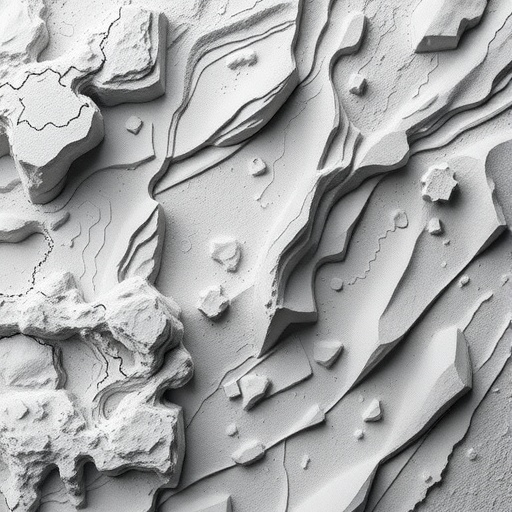In recent years, the field of artificial intelligence (AI) has witnessed remarkable advancements, particularly in the generation of images and visual content. Among the exciting developments is a cutting-edge technology termed shallow relief effect generation. This is an innovative approach that integrates enhanced U-Net architectures with normal style transfer techniques, enhancing the capabilities of artists and designers across various disciplines. The implications of this work, as elucidated in Liu’s research, could prove transformative for the artistic community and beyond.
At the core of this technology is the U-Net, a convolutional neural network designed initially for biomedical image segmentation. However, its architecture has seen successful adaptations across a range of visual tasks. Liu’s improved U-Net model innovatively incorporates style transfer methodologies, allowing for the generation of shallow relief effects, which translate two-dimensional images into compelling, textured representations. This fusion of concepts from deep learning not only showcases the versatility of U-Net but also emphasizes the significance of style transfer in modern AI applications.
Shallow relief effects create a visually appealing appearance by simulating depth in a flat image. Traditionally, achieving such effects required substantial manual intervention or complex graphical software. Liu’s research proposes that this process can be automated through AI, proposing a systematic methodology to achieve stunning results with minimal user input. This development opens a new dimension for artists, allowing them to focus on creativity rather than technical execution.
The study further highlights how improved U-Net structures offer better feature extraction, resulting in more finely detailed outputs. By integrating these features with normal style transfer methods, the capability to preserve artistic styles while generating depth is enhanced. This results in images that not only mimic real-world textures but also embody the stylistic intentions of numerous artistic movements.
An important aspect of this technology is its accessibility. With the increased computational power of modern hardware and the availability of user-friendly AI tools, artists can harness these innovations without requiring extensive programming knowledge. Liu’s research thus democratizes access to advanced image processing techniques, encouraging broader exploration within the art community. This technology can be harnessed in various applications, from digital illustrations to virtual reality environments, enriching diverse sectors such as gaming, film, and even advertising.
Moreover, Liu’s work paves the way for further research into AI’s role within creative fields. By providing a foundation for the exploration of additional artistic effects and capabilities, the research not only emphasizes the original contribution of the U-Net integration but opens up questions regarding future innovations in AI artistry. The potential for AI to assist in aesthetic decision-making marks a significant shift in how art may be produced and consumed.
As the technology evolves, ethical considerations around AI-generated art are becoming more pressing. Issues such as copyright, originality, and the relationship between human artists and AI tools raise essential discussions within the realm of creativity. Liu’s research touches upon these themes, prompting necessary reflections on artistry in the context of rapid technological advancements. The community must grapple with how this technology and others like it affect the value and authenticity of artistic expression.
Despite these considerations, the excitement surrounding the implications of Liu’s findings cannot be overstated. Imagine an artist comfortably generating intricate textures and depth in their work, tapping into an AI’s capabilities to manifest their vision with unprecedented ease. The collaboration between human creativity and machine-learning presents boundless possibilities for what art can be in the digital age.
Furthermore, Liu’s study examines the technical intricacies involved in creating an improved U-Net specifically tailored for shallow relief effects. By detailing the alterations made to traditional U-Net configurations, such as adjustments in the loss functions and optimization algorithms, the research provides readers with insight into the intricate workings that contribute to the success of the algorithm. Such discussions are crucial in pushing the boundaries of what AI can do in image generation.
As we delve deeper into the mechanics of this technology, the potential for customization and personalization becomes evident. Artists can favor certain styles or concepts, translating their preferences into codes that the improved U-Net can interpret, resulting in imagery that is unique and personal. This aspect is particularly enticing for musicians, writers, and creators across various domains seeking to integrate visual dimensions into their work.
The feasibility of real-time processing indicates that performances and installations could be enhanced through this technology. Audiences could experience dynamic visual displays as they engage with live performances, hinting at a future where art is a multisensory experience, merging auditory and visual stimuli in innovative ways.
In conclusion, Liu’s research on shallow relief effect generation using improved U-Net technology and style transfer showcases an exciting convergence of art and AI. As tools for artistic creation evolve, they carry immense potential to reshape our understanding and appreciation of art. The ripple effects of these advancements could inspire a generation of creators and thinkers, furrowing deeper into the artistic potential of AI. The implications of integrating such advanced technologies into artistic processes may redefine how we engage with creativity in the digital landscape.
The future of AI in art, fueled by innovative research like Liu’s, invites us to envision a world where technology not only complements but enriches the human experience of creativity.
Subject of Research: Shallow relief effect generation technology using improved U-Net and normal style transfer
Article Title: Shallow relief effect generation technology integrating improved U-Net and normal style transfer
Article References: Liu, X. Shallow relief effect generation technology integrating improved U-Net and normal style transfer. Discov Artif Intell (2025). https://doi.org/10.1007/s44163-025-00632-y
Image Credits: AI Generated
DOI: 10.1007/s44163-025-00632-y
Keywords: shallow relief effects, U-Net, style transfer, AI, image generation, creative technology, digital art, visual representation
Tags: AI for artists and designersartificial intelligence in artautomated image processing solutionsconvolutional neural networks in designdeep learning applications in artenhanced U-Net architectureshallow relief effect generationstyle transfer techniquestexture simulation in digital arttransforming two-dimensional imagesU-Net adaptations for visual tasksvisual content generation advancements





